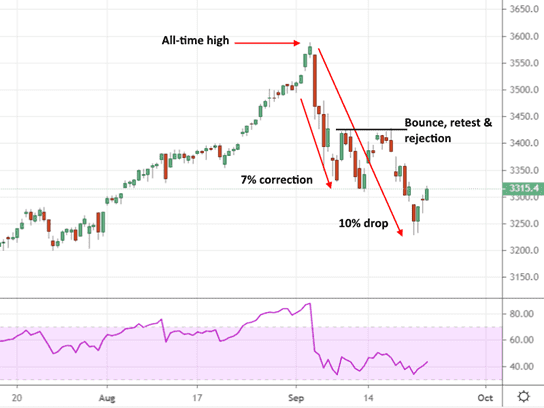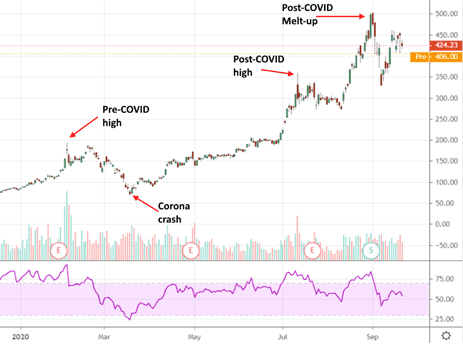There’s an old saying, “make hay while the sun shines,” meaning that you should make the most out of your opportunities while they last. The adage is particularly relevant to our financial markets of late, as it seems investors have been taking it quite literally over the course of the summer. Even as markets across the board were falling following the worldwide spread of the coronavirus, the urge to find the right dip to buy became ever harder to resist. At the time, with flu season out of the way (at least in the northern hemisphere), we witnessed a powerful recovery as well as an increase in confidence that the worst was behind us, that a vaccine was just around the corner, and that a full return to growth was on the cards for 2021.
Of course, collective sentiment tends to overshoot on both the upside and the downside. When things are bad, it often seems like the end of the world; when they’re good, it feels like the party’s never going to end. What we seem to be witnessing now is a moment of collective sobering up. Winter is coming, COVID-19 cases are on the rise again, further lockdowns appear to be in store, and investors don’t want to be caught wrong-footed like they were back in March.
Market Sell-Off
Following the slump in US equities that we saw in early September from their all-time highs, the S&P 500 has attempted to bounce, stalled at the 3422 level between September 8-10, unsuccessfully retested the same level between September 15-16, and has since set a new lower-low at around 3230. We’ve seen the Dow Jones Industrial Average and Nasdaq do much of the same thing, with the S&P 500 and Nasdaq recently hitting levels last seen in July, and the Dow Jones since early August. On Monday, September 21, for the first time since February, the S&P 500 posted losses on four consecutive days. It ended around 10% down from the record high the index set on September 2.
As is routinely the case, each bounce is met with a great deal of fanfare. The S&P 500 is currently up around 2.9% off those lows, but there could be further selling in store. The attempted bounce we’re seeing is currently being led by tech giants Amazon and Apple. The other usual subjects in the technology space (Microsoft, Alphabet and Facebook) have, in combination, fuelled the US stock market’s improbable post-COVID-19 rally and have also posted slight gains since the sell-off.
Market Worries
What we’re seeing now is a period of coming back down to earth and a tentative recognition that perhaps stocks rallied too hard through the summer to become overpriced relative to the risks. The first of the unknowns weighing on investors’ animal spirits is whether Congress will approve further stimulus measures before the November election. This was echoed by Fed chairman Jerome Powell, who has publicly called for further fiscal support from the government. With the unemployment benefits and other stimulus measures of the CARES Act having recently expired, the big question on everyone’s lips is whether a deadlocked Washington will manage to put together another package.
US-China tensions are also continuing to rise with President Trump gunning for the Chinese tech platforms. Citing data privacy and national security concerns, the US Department of Commerce has recently launched a series of measures that will severely curtail the US activities of Chinese tech companies like TikTok and WeChat.
In other news, the recent death of Supreme Court Justice Ruth Bader Ginsberg has added further tensions in an already fraught election run-up as Republicans and Democrats begin an acrimonious battle over who is to replace her.
All the above is taking place amidst an uptick in coronavirus cases. Aside from the United States, the top 15 list of daily coronavirus cases has been dominated by the developing world throughout the summer (mostly South America, India and Russia). Recently we’ve seen Spain and France re-emerge with an explosion in daily cases and now the UK is also making its way back up the list. On Sunday, September 20, the UK reported 4422 cases, the highest case count since May. With new cases and hospital admissions doubling every week, it’s now becoming apparent to leaders in the northern hemisphere that a second wave is almost upon us, that the relaxation of measures throughout the summer and encouragement of the public to go out and spend, has given the virus a foothold just as the flu season is about to begin.
Tesla in the Spotlight
The stocks that run the hardest during the irrational exuberance of a rally can be the ones that sell-off the hardest when outlooks begin to change. Pre-COVID, Tesla peaked in February at around $193 per share. Post-COVID it surged to around $360 in July and then catapulted to $500 in late August to the complete bemusement of most onlookers.
Tesla stock was hit particularly hard during this recent sell-off. On September 8 it gapped down upon opening and went from $417 on Friday’s close to around $330 on Tuesday’s close. That’s a more than 21% drop, the worst single-day performance in the company’s entire history, which wiped more than $80 billion from the company’s valuation. From peak to trough, Tesla corrected by over 34% in September. True to form, the rebound has been even more impressive, having bounced by more than 38% since the September 8 low to set a lower-high at around $463.
Aside from the technicals, what else is weighing on Tesla's much-loved story stock? Well, for one, it was widely anticipated that the company would be added to the S&P 500. This did not come to pass as the committee responsible for vetting new entries decided against the addition. More recently, the company’s CEO, Elon Musk, has stated that the company may experience difficulties in scaling up production following an analyst’s warning that its heavy reliance on aluminium parts could pose problems. Finally, even though the stock behaves and is often treated as a sort of honorary tech stock, the reality is that it’s an auto manufacturer that could be severely affected by the second wave of coronavirus infections and lockdowns. This is due to supply chain disruptions but also shifting priorities among consumers if the global economy is due to suffer another hit. Tesla is definitely a stock to watch as the potential downside is great should the worst come to pass, as well as the inevitable bounces following each sell-off.
About HYCM
HYCM is the global brand name of Henyep Capital Markets (UK) Limited, HYCM (Europe) Ltd, Henyep Capital Markets (DIFC) Ltd and HYCM Ltd, all individual entities under Henyep Capital Markets Group, a global corporation founded in 1977, operating in Asia, Europe, and the Middle East.
High Risk Investment Warning: Contracts for Difference (‘CFDs’) are complex financial products that are traded on margin. Trading CFDs carries a high degree of risk. It is possible to lose all your capital. These products may not be suitable for everyone and you should ensure that you understand the risks involved. Seek independent expert advice if necessary and speculate only with funds that you can afford to lose. Please think carefully whether such trading suits you, taking into consideration all the relevant circumstances as well as your personal resources. We do not recommend clients posting their entire account balance to meet margin requirements. Clients can minimise their level of exposure by requesting a change in leverage limit. For more information please refer to HYCM’s Risk Disclosure.
References:
https://www.voanews.com/economy-business/us-stocks-fall-global-markets-swoon
https://www.worldometers.info/coronavirus/


